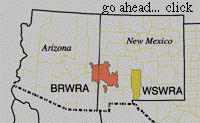
Using GIS to Develop an Endangered Species Recovery Plan
by John Andrews
CE 397/ Instructor: Dr. Maidment
OBJECTIVE: To determine if Big Bend National Park and adjacent protected areas constitute a viable reintroduction site for Mexican wolves based on road density, elevation, and vegetation.
INTRODUCTION: The Mexican Wolf (Canis lupus baileyi)
is extinct in the wild. This animal, one of five subspecies of
gray wolves known to North America,  ranged throughout central and northern Mexico and
the American Southwest in pre-Columbian times. Over the past
hundred years, however, Mexican wolves have been severely
persecuted by man and were driven to extinction in the United
States approximately fifty years ago. Though a remnant, dwindling
population managed to hang on in the Sierra Madre Occidental
mountains of western Mexico, most wildlife biologists today
believe that even these animals are now extinct and that there
are thus none left in the wild.
ranged throughout central and northern Mexico and
the American Southwest in pre-Columbian times. Over the past
hundred years, however, Mexican wolves have been severely
persecuted by man and were driven to extinction in the United
States approximately fifty years ago. Though a remnant, dwindling
population managed to hang on in the Sierra Madre Occidental
mountains of western Mexico, most wildlife biologists today
believe that even these animals are now extinct and that there
are thus none left in the wild.
Fortunately, before the
animal had become extinct, the United States Fish and Wildlife
Service captured five Mexican wolves in  Mexico--a
female and four males--and brought them back to the United States
to start a captive-breeding program in the late 1970s. Today
there are nearly 150 offspring from these original wolves
populating zoos and holding pens from Phoenix to Houston. The
Fish and Wildlife Service's goal is to return some of these
animals back to the wild. In the mid-1980s, however, when the
Fish and Wildlife Service asked the state wildlife agencies of
Arizona, New Mexico, and Texas to investigate possible wolf
release sites in their respective states, the wildlife agencies
of New Mexico and Arizona agreed to cooperate. Texas Parks and
Wildlife, however, did not. As a result, extensive research has
been undertaken to determine which areas in Arizona and New
Mexico might be suitable wolf habitat. No such studies have been
performed in Texas.
Mexico--a
female and four males--and brought them back to the United States
to start a captive-breeding program in the late 1970s. Today
there are nearly 150 offspring from these original wolves
populating zoos and holding pens from Phoenix to Houston. The
Fish and Wildlife Service's goal is to return some of these
animals back to the wild. In the mid-1980s, however, when the
Fish and Wildlife Service asked the state wildlife agencies of
Arizona, New Mexico, and Texas to investigate possible wolf
release sites in their respective states, the wildlife agencies
of New Mexico and Arizona agreed to cooperate. Texas Parks and
Wildlife, however, did not. As a result, extensive research has
been undertaken to determine which areas in Arizona and New
Mexico might be suitable wolf habitat. No such studies have been
performed in Texas.
Based on these studies, the
US Fish and Wildlife Service and the state wildlife agencies of
Arizona and New Mexico have proposed two wolf reintroduction
sites- one in New Mexico (the White Sands Missile Range) and the
other along
the Arizona-New Mexico border (the Gila and Apache National
Forests). Because Texas Parks and Wildlife refused to participate
in this program,
along
the Arizona-New Mexico border (the Gila and Apache National
Forests). Because Texas Parks and Wildlife refused to participate
in this program, however, no
potential release sites in this state have been considered or
studied for Mexican wolf suitability despite many environmental
groups' and individuals' claim that the Big Bend area of west
Texas and northern Coahuila and Chihuahua might be an excellent
reintroduction site. The purpose of this project--and my
thesis--is to answer this question: Could the Big Bend region
sustain a wild population of Mexican wolves?
however, no
potential release sites in this state have been considered or
studied for Mexican wolf suitability despite many environmental
groups' and individuals' claim that the Big Bend area of west
Texas and northern Coahuila and Chihuahua might be an excellent
reintroduction site. The purpose of this project--and my
thesis--is to answer this question: Could the Big Bend region
sustain a wild population of Mexican wolves?
Wildlife biologists consider a number of factors in determining which areas are suitable for wolf reintroduction, including prey density, human population density, livestock density both within and adjacent to a prospective release site, vegetation type and density, road density, and elevation. Though I will be investigating all of these factors and others for my thesis, I will focus the later three for this project.
